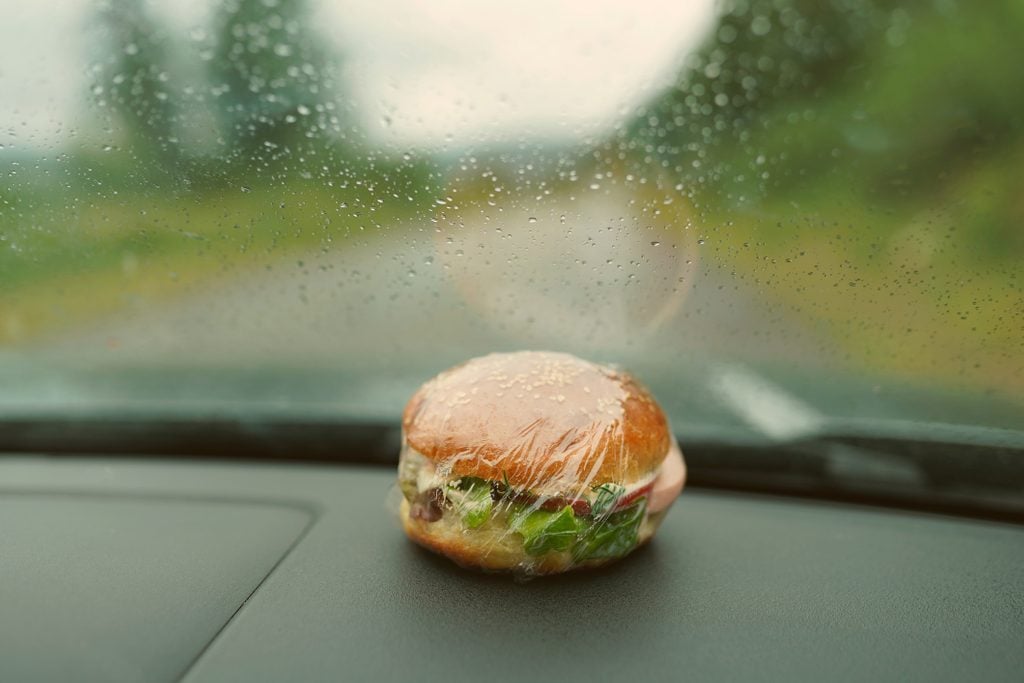Why You Should Never Leave Food in the Car
Updated: Nov. 27, 2022

If you're still tempted to bring food with you and leave it in the car, time your journey.
Eating on the road
There are a variety of reasons why you might bring food in your car. Maybe you just went grocery shopping to stock up for the week, or maybe you’re getting ready for a weekend road trip. Perhaps you’re heading home and have a take-out bag from the restaurant. Regardless of the reason, it’s important to know about food safety when driving in your car, especially in hot weather.
Food safety: the basics
As more people are cooking meals from home and traveling, it’s important to learn about food safety. “Food safety is especially important if there are any children under 5 years of age, pregnant women, adults over 65 years of age or anyone with medical conditions, such as cancer or diabetes, living in your household,” Lauri Wright, PhD, RDN, Spokesperson for the Academy of Nutrition and Dietetics and Chair of the Department of Nutrition & Dietetics at the University of North Florida, tells Reader’s Digest. “To keep food safe, we need to avoid the ‘danger zone.’ Bacteria grow most rapidly in the range of temperatures between 40 °F and 140 °F, doubling in number in as little as 20 minutes.”
A car’s temperature
You might be surprised at how hot an unairconditioned car can get in some parts of the country throughout the year. “During the summer months, the interior of a closed-up vehicle can easily reach 140 degrees Fahrenheit here on the east coast,” John Burkhauser, an auto repair specialist and director of educational programs at Bolt On Technology, tells Reader’s Digest. “In other sections of the country where the ambient temperature gets as high as 115 degrees, the interior temperature can go even higher.”
That means your food is going to get really hot, really fast. “In reality, no foods should be exposed to these temperatures for long because the food itself is not only the problem, the container or wrapping of the food usually is not designed to withstand these temperatures and may also interact with the food,” explains Burkhauser. This also explains why plastic water bottles have expiration dates.
How to keep foods in cars safe
In general, foods should be in coolers and hot food should be kept hot. “Place cold food in coolers with frozen gel packs or ice. Stashing it at 40°F or below prevents bacterial growth,” says Wright. “Consider packing beverages in one cooler and perishable foods in another since you are likely to grab beverages most often. Sliced fruit and veggies, hummus, guacamole, and yogurt are good snacks to store in the cooler.” To keep hot foods hot, Wright recommends passing on hot food except for cases where there’s a portable heating unit that can be safely used.
Burkhauser adds that foods that are less vulnerable to high temperatures like energy bars, beef jerky, and nuts should be added to coolers as well.
Food safety in cars with and without air conditioning
Even though it might seem common practice to leave food out in the car, it’s something that should be discouraged. Wright says that foods can reach the “danger zone” for bacterial growth quickly in unairconditioned cars. “Perishable foods like dairy and salads containing mayonnaise are especially dangerous and should be avoided. The opposite is true for hot foods in an air-conditioned car. Meat can be especially dangerous so should be avoided.”
Food safety applies to all foods, regardless of whether it’s fresh or frozen. Air conditioning doesn’t preserve or keep food cool, either. “Even if the air conditioning in a vehicle is working perfectly, the temperature of the air coming out of the vents usually is above freezing so frozen food should not be left in the vehicle for long with the AC on,” says Burkhauser. Burkhauser adds that drivers should be careful of sunlight entering the car since it can warm up anything in its light.
There are a few things you shouldn’t bring
If you’re going for a long drive, you’re probably going to be hungry while on the road. “Frozen and perishables should not be brought along on long trips unless you want to have one more thing to worry about such as getting ice to keep these things cold,” says Burkhauser. If you’re planning a road trip, here are the best road trip snacks to bring with you.
Foods can actually damage your car
It’s not only food safety that’s an issue, but any food leftovers that you find as a surprise after the fact. “Yes, any food left in a hot vehicle over time will at least make it stink,” says Burkhauser. “Of course, frozen foods will run as they thaw making a sticky mess. With open USB ports and the like, any food that should melt and seep into them will cause connection issues.” If you’ve ever reached for your coffee in the cup holder and made a sudden stop, you know what happens next. “Coffee and soda left in the center console by the transmission shifter can get spilled into it causing issues with getting it in and out of gear,” adds Burkhauser. Eating in your car isn’t a great idea anyway and is one of the things you’re probably doing in your car, but shouldn’t.
Bottom line
If you’re still tempted to bring food with you and leave it in the car, time your journey. “Don’t eat food if it has been in the car more than 2 hours,” Wright says, “1 hour if the temperature is over 90 degrees.” She adds that you should avoid milk-beverages if they aren’t stored in a cooler. However, there are a few non-perishable snacks that you can have: whole or dried fruit, freeze-dried vegetables, trail mix, and whole-grain snack bars. Next, make sure you know these 15 road trip planning tips you need before you go.
Sources:
- Lauri Wright, PhD, RDN, Spokesperson for the Academy of Nutrition and Dietetics and Chair of the Department of Nutrition & Dietetics at the University of North Florida
- John Burkhauser, an auto repair specialist and director of educational programs at Bolt On Technology
